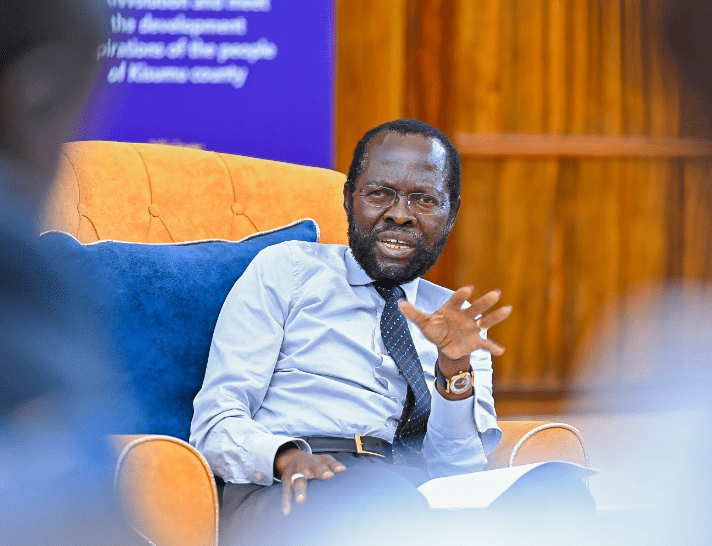Oparanya leads the pack of best performing county chiefs

Emeka-Mayaka Gekara
Kakamega Governor Wycliffe Oparanya and his Kwale counterpart Salim Mvurya are the best performing governors, according to a new survey released yesterday.
They are followed by Makueni’s Kivutha Kibwana, Prof Anyang’ Nyong’o (Kisumu), Jackson Mandago (Uasin Gishu), John Lonyangapuo (Pokot), Alex Tolgos of Elgeyo Marakwet and Bungoma’s Wycliffe Wangamati, while Alfred Mutua (Machakos) and Kericho’s Paul Chepkwony tie at number nine to complete the top ten list of exemplary performers.
The country’s 47 counties were ranked based on their performance in responsibilities assigned to the devolved units, such as Agriculture, Education, Health, Water Management, Transport, Trade, Planning, Sports, Energy and Tourism.
The governors were also ranked on their commitment to the fight against corruption, drug abuse and pornography.
The survey, by research firm Infotrak, was conducted between October-December 2019 and January 2020.
It ranks Tana River’s Godhana Dhado as the worst performing county chief, followed Wajir’s Mohamed Abdi, Mohammed Kuti (Isiolo), Moses Lenolkulal of Samburu, Mandera’s Ali Roba, Patrick Khaemba of Trans Nzoia, Narok’s Samuel Tunai, John Nyagarama (Nyamira), Cyprian Awiti of Homa Bay and Ali Korane of Garissa.
According to Infrotrak Chief Executive Angela Ambitho, some governors registered significant improvement from their performance in 2015 when a similar survey was conducted while others dropped dramatically.
“While most county governments spent the nascent period predominantly laying the ground work and planning aptly in order to deliver on the promises, others grabbed the opportunity not only to lay the operating framework, but also to actualise quick wins that have continued to resonate with the public,” said Ambitho.
There was discernible evidence that majority of governors whose performance had dipped were serving their second terms, notably Mombasa’s Hassan Joho, Awiti, James Ongwae (Kisii), Sospeter Ojaamong of Busia, Tunai and Mwangi wa Iria (Murang’a).
The study, however, did not explain the reason for the drop, but it could largely be attributed to the fact that the second-term county chiefs could have dropped their guard or ambition because they were no longer threatened with an election.
Indeed, some first-term governors such as Kisumu’s Nyong’o, Pokot’s Lonyangapuo and Tharaka Nithi’s Muthomi Njuki recorded impressive performances overtaking a big number of those serving their second term.
According to Ambitho, the scorecard is part of the firm’s CountyTrak Performance Index, which gauges residents’ assessment on the performance of their county governments.
Star governor Oparanya, who is the chairman of the Council of Governors, scored 57.2 per cent, Mvurya (54.8 per cent), Kibwana (54.7 per cent) and Nyong’o 53.4 per cent.
Uasin Gishu’s Mandago returned a 53.1 per cent approval rating, Lonyangapuo (52.7) followed by his neighbour Tolgos with 51.2 per cent, Bungoma’s Wangamati (51.1 per cent) while Mutua and Chepkwony tied at 50.6 per cent.
Makueni, Turkana, Kisumu and Lamu counties were ranked as the top climbers. Makueni, which emerged third, was ranked at number 40 in a similar survey in 2015, Turkana (42), Kisumu (27) and Lamu, 37.
Other top climbers were Kakamega, which had been placed at 10 in 2015, Nairobi, which improved from position 39 to 20, Tharaka Nithi (31 to 12), and Marsabit, from number 44 to 35.
Among counties whose performance had dropped drastically, according to the survey, include Taita Taveta (from number 9 in 2015 to number 36) and Samburu, which dipped to number 44 from 21 in 2015. Mombasa sunk to 34 from 14 while Kisii dropped from number 7 in 2015 to 21 in the current study.
On health, Makueni, Kwale, Kakamega and Machakos emerged the top five leading counties credited for expanding and equipping their hospitals.
The report shows Makueni county scored 64.4 per cent, followed by Kwale (61.4 per cent), Kakamega (60.8 per cent), Machakos (58.3 per cent) and Kisumu at 57.3 per cent
Narok, Mombasa, Kiambu (then under Ferdinand Waititu) and Tana River were listed as the worst performers on matters health. It was demonstrated that top five counties had improved the provision of health care to the residents.
“The reason behind their top performance is because they are able to make it easy for families to get affordable medical treatment when needed, ensure that people receive information on how to stay healthy and avoid diseases as well as ensure that restaurants and kiosks that sell food are licensed to do so and inspected regularly,” the report says.
“The five counties have ensured that health concerns in their respective counties have been handled to their satisfaction whenever they visit a public facility, ensure there are adequate sanitation facilities as well as have ensured that there are necessary medical equipment and medicine.”
Kakamega was ranked the best performing county in the agricultural sector.
The county scored 53.4 per cent followed by Lonyangapuo’s West Pokot, a previously marginalised county that was largely famous for banditry and high illiteracy levels.
Makueni emerged third with a 50.4 per cent score, followed by Bungoma county with a 48.9 per cent score and Uasin Gishu sealing the top five with a 48.4 per cent score.
The survey shows that Kwale was the best performing county on expansion of education facilities followed by Kakamega, West Pokot, Makueni and Uasin Gishu.
“Key performance indicators were ensuring that there are enough nursery schools or Early Childhood Development centres in counties that have good facilities and teachers,” said the report.
The survey measured how counties have ensured that needy, vulnerable and gifted children obtain bursaries and availability of equipment for polytechnics.
Wajir is the worst county on education alongside Narok, Isiolo and Mandera.










